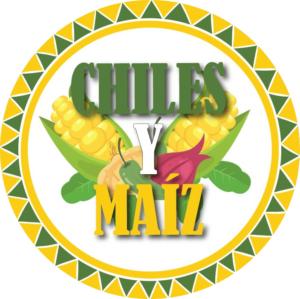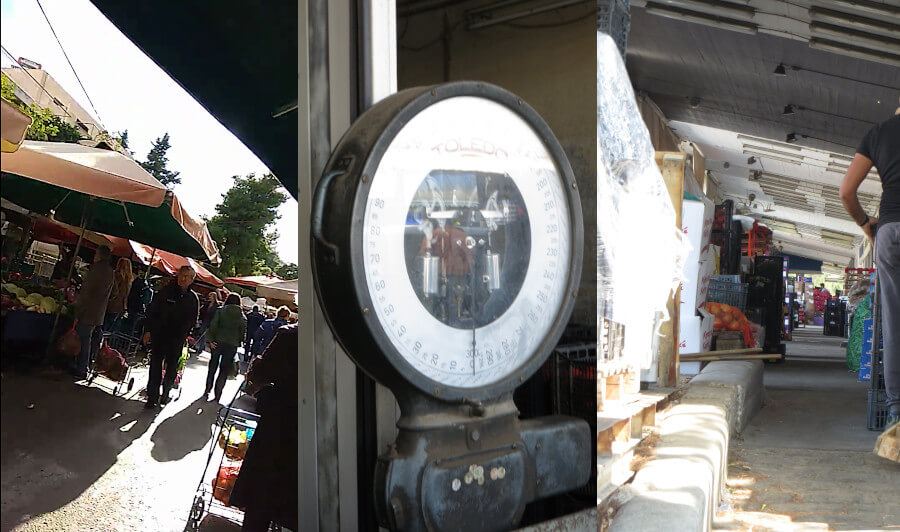3 Chronicles of Tianguis and Markets in Athens
Lately, I'm nostalgic for Mexico. Images come to me of places I used to frequent. Shops, cafes, food stalls and parts of various cities that I have toured. I don't know why but I have constant flashes of memory of the street markets and the markets! Of people shouting and showing their merchandise in their eagerness to sell. Approaching your prospect, asking, “What do we show you boss, what do you fancy? I have… ”, followed by a large listing of their products, pausing from time to time to mention the wonderful use of such an item and moving on to the next passerby when they realize they are not going to buy the previous one.
Contents
First chronicle: Market on wheels - Tuesday's tianguis
Video: The tianguis on Tuesday
Second Chronicle: Central Market of Athens (Varvakios)
Video: Central Market of Athens (Varvakios)
Gallery: Some shops in the streets surrounding the “Varvakios” market
Third Chronicle: The Athenian Supply Center
Video: OKAA time lapse

Courtesy of Augusto Romero
License: GEnérica Attribution / Share-Alike 3.0
In Mexico, going out into the street, you unite with your surroundings, vibrant and colorful. The cities are alive, the people are warm. In contrast, the cities of Europe are more orderly. There are fewer people selling on the street and when you do, it looks and feels more formal and established. There are no crates with trays on top, full of toys, clocks and endless trinkets. Everything is of a more sublime tone, more structured, more systematized. Or may it not be so?
Athens, the capital of Greece, is located on a European peninsula that is wet by the waters of the Mediterranean and is on the borders of the European Union. To the east is Turkey, Syria and the Middle East and to the south is Africa. Born and partially raised in the city of Athens, I cannot say that I have memories of a city regulated and conditioned to European standards. And although that was a long time ago, living here for the last four years, things are not much changed. Sure, there is more order than back then but if you compare it with the current metropolises of Europe, the differences are remarkable.
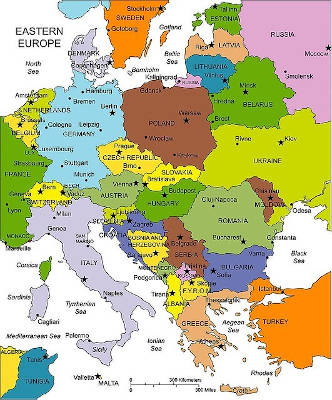
Courtesy of Nathan Hughes Hamilton
License: Attribution 2.0 Generic (CC BY 2.0)
Arousing my curiosity, I decided to investigate the matter and see how many similarities with the markets of Mexico I would find. Speaking of my recent concern to Berenice, my wife and fellow blogger, caught her attention enough to shake us up and get going. And so we began to get into the various types of markets that we find in our fixation of knowing more about those of this country and its proximity to those of Mexico.
I separate this report into three parts. Three chronicles in which I will tell you about our visits to three different markets of character and training. The first, the most accessible to us, is where we usually do our purchases. One of "on wheels", mobiles or markets, better known as tianguis in Mexico. The second is the central market of Athens and lastly, the central supply or wholesale market. Let us begin!
First chronicle: Market on wheels - Tuesday's tianguis
The tianguis were my first contact with the markets when I returned from Mexico. They move in all areas of the city once a week and you can find fruits and vegetables, fish and seafood, clothes and shoes, plants and flowers and articles and products for the home. Actually, they function like a supermarket but their merchandise is supposed to be offered at lower prices. Although this is true when it comes to fruits and vegetables, in general it is good to compare prices since many products can be found with generous discounts in the supermarket.

The tianguis in our area is put on every Tuesday and we visit it faithfully. It is here that we come across the first difference between the tianguis of Mexico and those of Athens: meat and chicken are completely lacking. The reasoning behind that is that without refrigeration, its sale could be a health risk. Fish are saved from the rule by being displayed on ice.
Although, we are going to stock our vegetables and fruits, my wife and I start from the clothes to look at them and move on to the products that interest us, the vegetables. It is suggested to go early to get the freshest but this can be argued knowing that the products for sale are perishable, which means that their prices fall as the day progresses.
However, many times buying later can result in a boomerang as on busy days the cool ends soon. Whatever time it is, the trick to buying the best quality for value is to go through the stalls twice, looking at everyone's prices and quality on the way out and buying back.
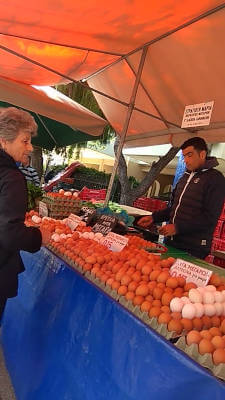
The truth is that like almost everyone, we have our favorite positions. For the most part, they are places where we have bought several times, most of them being satisfied. Even so, a lot has to do with the treatment that is given to the client. A smiling face can exceed quality and price, at least sometimes. A nimble salesman with a smack can get rid of his merchandise quickly, even if it's not the best in the street market. But that is something known and valid throughout the world of buying and selling, as it is also known that the customer is always right since it is he who will decide who to leave his money to.
So we march through the aisles of the flea market, looking from bank to bank, looking for the products that will come to occupy a place in our shopping basket. They have to have some common traits here and in China… and of course, in Mexico! They are the famous 3B or good, nice and cheap.
However, seeing the quality of the merchandise is one thing and seeing or rather looking at the price is another. Unfortunately, you still find signs with the pennies written in small print, which makes distinguishing the true price difficult, especially for the elderly and poor-sighted. After all, between .00 and .99, there is almost a euro and it is invisible!
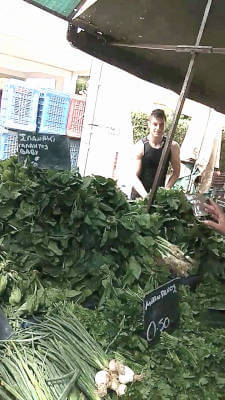
Our first stop is with the guy who sells quelites, herbs and vegetables in general. We visited his stall because he is one of the few who almost always brings coriander, a herb that most Greeks do not like very much, despite being the most widely used in the world. For this reason, outside the rainy seasons, coriander is difficult to find.
But our little friend, knowing the importance that we Mexicans give him, pleases us and he has a few things in hand for us so that our waters do not break. No occasion goes by without adding some herb as a gift. After all, public relations and marketing go hand in hand.
The next stop is with him who sells olives to buy Kalamata olives that I like so much personally. The young man is always very gentle and offers us to try the varieties he handles. Sometimes we buy green ones, others pickled black ones. The olive has its value well rooted with the Greek people. It has been in their diet for thousands of years and is sought after like chili peppers by Mexicans. We bought a half kilo and we continued on our way.
There, where the fruits and veggies end, are the peanut and candy ladies. Mother and daughter. They both want to learn to speak Spanish and they make an effort but they see it as impossible. They tell us a "come estay" and laugh, knowing that they did not say it well. It does not make it, it is the effort that matters. It is this effort that has us convinced that they sell the freshest peanuts of all the stalls.

Also, we like that they have their terminal to receive credit / debit cards. It is a sign of the desire to sell in certainly difficult conditions, taking into account the crisis from which the country is just emerging. But let me explain.
For about a year, having a terminal in all points of sale, including stalls, taxis and bill collectors, is mandatory. This means that a percentage of the sale is set aside for the bank's commission, which can make anyone unhappy! To be happy then, most of the stalls have them hidden. Even so, paying with a card at the tianguis is something totally unknown in Mexico, until now. However, it is not something desired by traders here either.
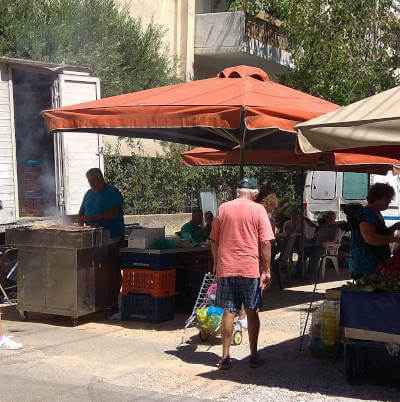
We put our pounds in the basket and continue towards the fish, always looking at the merchandise and prices to locate the bargains. Suddenly, we get the unmistakable smell of roast meat. To our left, a man is busy filling his grill with “souvlaki,” the pork chunk skewers whose fame has spread worldwide. He takes care of them meticulously so that they do not burn, turning them in intervals until it is time to remove them from the fire. Even if you are not hungry, your appetite is whetting but we are quite disciplined now and we can hold the craving. We passed it with “indifference”.
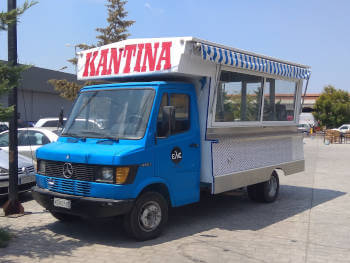
In contrast to the tianguis of Mexico, those of Atenas do not offer much prepared food, probably due to hygiene regulations. In the one in our area, only he gets the "souvlaki" and I have witnessed other tianguis without absolutely no food. Sometimes you come across a “food truck”, curiously known as a cantina or “καντίνα” in Greek, but still, Mexican snacks are missing.
Arriving at the fish section, a strong change in smell is felt. The air is filled with the aromas of the sea and the beaches full of seafood restaurants are craved. Despite the 6000 islands scattered in the Aegean and Ionian Sea, 227 of which are inhabited, the delicacies of the sea are not cheap in Greece. Minus the shrimp that are mostly imported from Thailand. As a result, cocktails are almost completely lacking and, being fish from the sea and not from the ocean, the fish tends to be prepared in other ways than those used in Mexico. Still rich but distinct in flavor.
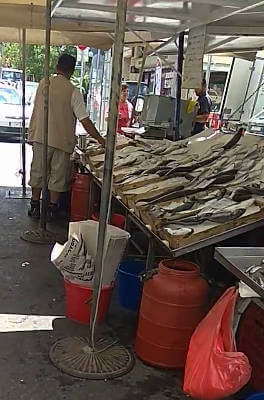
We turn to take the road back and shopping. We already know where to go. The lady who is almost at the beginning has good potatoes and at a good price. Today, we also saw cheaper strawberries than in Mexico. At only 3 euros the huacal! This, it is an offer.
We bought it even without knowing how it was going to take home. Strawberry can be found cheaply, only within its season in Greece. The rest of the time, it is imported from Israel and is different in taste and of course, in price. You have to take advantage of it, making a delicious snow!
There are watermelons, melons and peaches. Tomatoes are wonderful and also cucumbers to prepare delicious Greek salads accompanied by feta cheese, sprinkled with oregano that is on a par with that of Mexico.
There are pineapples and petacones mangos, most from the island of Crete or imported from Africa and also, you can find avocados from the same origin with the disadvantage that they are almost always immature and have to be wrapped in newspaper and wait until they reach His point. No "give me one for today, one for tomorrow and one for the day after tomorrow." That is luxury here.
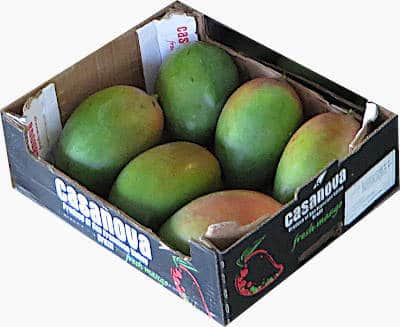
In contrast, there is a noticeable shortage of the other tropical fruits like papaya and guava, to name two. Also made from tubers, such as jicama, although you can find sweet potatoes and of course, not even think about finding tamarind. Speaking of tamarinds, Greeks are not used to drinking flavored waters and speaking of waters, they are not very fond of soft drinks either.
And what would a street market be without jammed chili stalls? It would be a tianguis in Greece since the Greeks for the most part are not lovers of spice either, although more and more people are looking for sauces and foods that "enchilan". If you are looking and you are lucky, you can find some medium-hot chili but it is not that easy. You would have better results going to the market in the center of the city or better yet, to the central de abastos, but we will talk about them later.
Our tianguis Tuesday ends with the least sensational part, which is the load of shopping at home. Very heated, one pulls and pushes the cart, while the other carries the crate. No way to leave everything in the street!
Second Chronicle: Central Market of Athens (Varvakios)
As an established market, we chose to visit the central market of the city of Athens. This specializes in the sale of meat and fish and is located in the heart of the city overlooking the Acropolis. Here, you can stumble upon the classic Monastiraki bazaar about 500 meters away and appreciate a plethora of businesses selling seas of street-style merchandise like Correo Mayor, Moneda, or Argentina in Mexico City. As fruits and vegetables could not be missing, there are also some that, apart from the locally accustomed varieties, are offered by some from the Indian subcontinent, where their owners come from.
The structure that gives roof to the “Varvakios” market, named after the architect who built it, was completed in 1886. Its completion, which had taken a long time, was speeded up after a great fire caused in 1884, which disposed of the old businesses. of the area that had been in operation since the days of the Ottoman Empire. In a neo-classical building with three wings, meat and fish are offered while vegetables extend to the street where there are shops that offer spices, legumes, cold meats and a great variety of foods.
Gallery
Some shops in the streets surrounding the "Varvakios" market
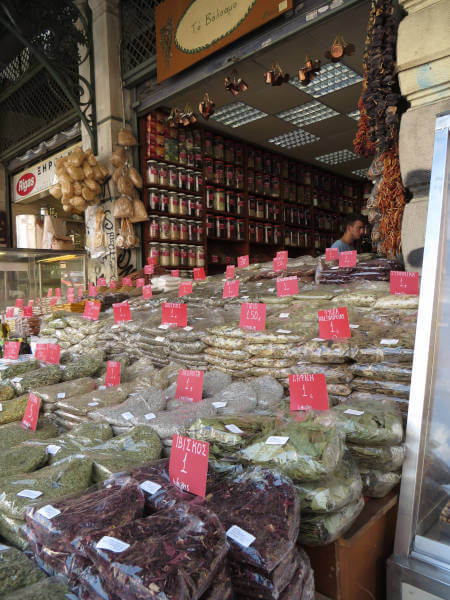
Spice 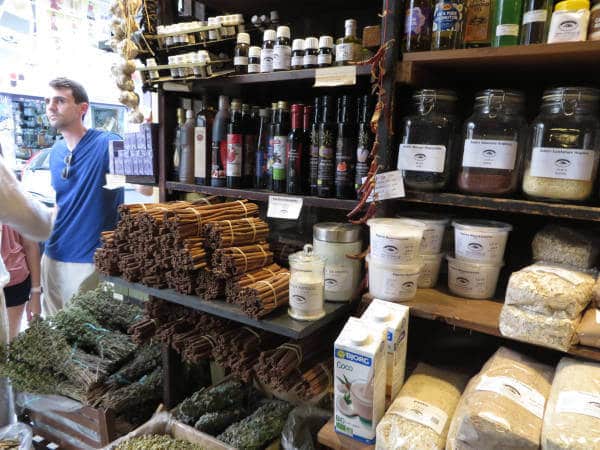
More spices 
Rice or legumes 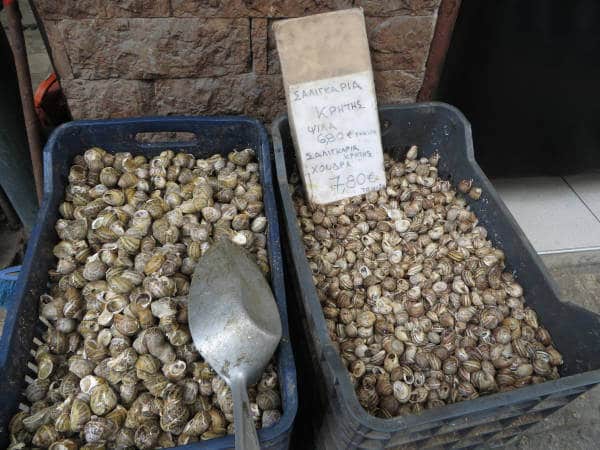
Snails 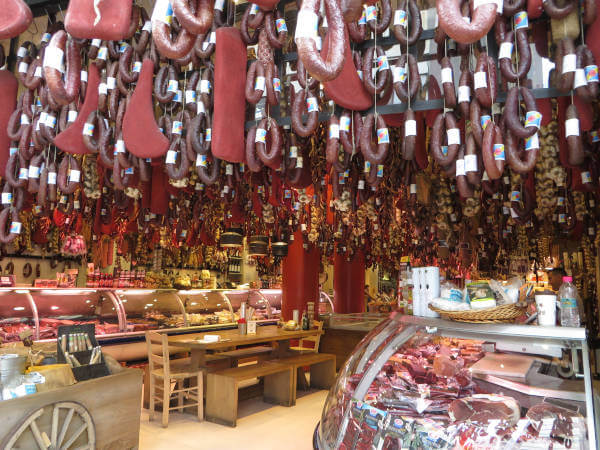
Cold meats 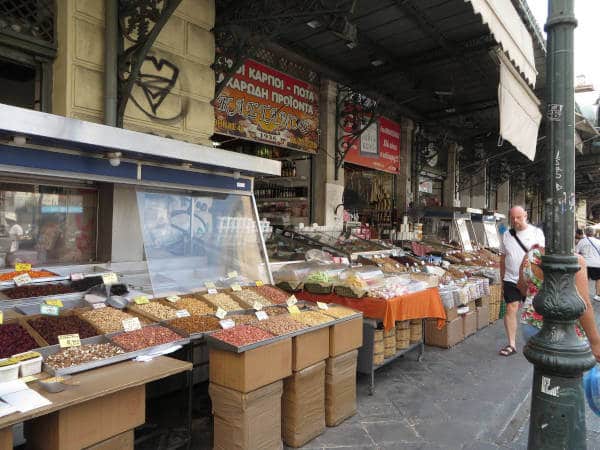
Nuts 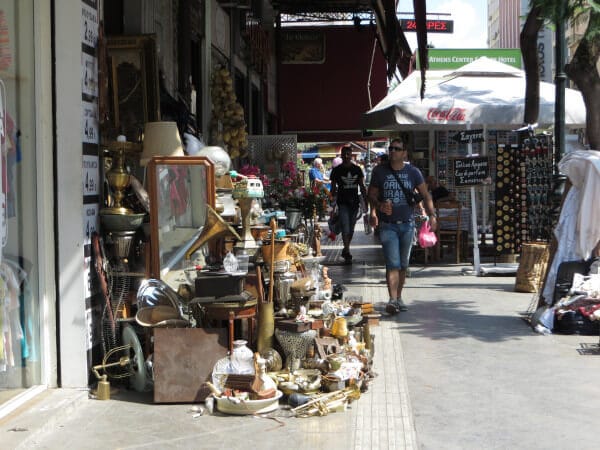
Antique Bazaar
I have not visited this market for many years, since the years of my youth. Unlike the Greek tianguis, this market has food stalls inside that, at least in the past, had some that stayed open until the early hours of the morning. These early risers offered “patsá” (πατσά) and “gloses” (γλώσσες) which, when translated, would be a kind of small and beef languages, respectively. As kids, we would roll to one of these establishments after a good drunk to eat since the “patsá” like the menudo, is considered miraculous for the hangover.

Courtesy of Kaihsu?
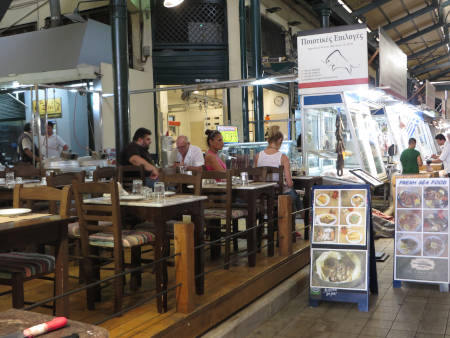
Although these restaurants do not have the clientele they had in the past, there are still a few on the fringes of the market, some of them with their doors open since the 19th century. However, the ones we saw on our visit offered traditional Greek food. and seafood and fish. It is good to know that if you get hungry stocking the pantry, you can sit down and enjoy some delicious and fresh dishes.
Crossing the “street of Athena” (Αθηνάς) to enter the central corridor, we remain dangerously in the middle of the traffic, captivated by the scene that can be appreciated when looking to the right: the sacred rock as it is known by the Greeks, where proudly sits the Acropolis. Few markets can boast a view like this!
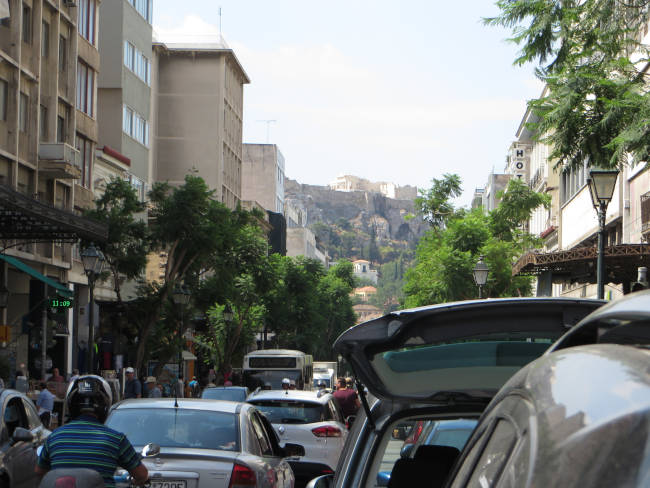
Awakened by the honking of horns, we quickly passed to the other side of the street and entered the market. Hung and spread out, various cuts of meat are displayed for the buyer's evaluation, waiting to be stuffed into some grocery bag. The prices are low compared to those of the butchers, since this is where they supply everything they sell. It is exhibited, beef and pork but also, goat and lamb, enclosed in glass counters that help protect it from the flies that always surround this merchandise.

Slowly we move down the aisle, passing stall after stall of all kinds of meat, shouting and inviting calls to appreciate their goods. In spite of the many kilometers that separate Mexico from Greece, one who understands the language cannot cease to be surprised by the similarity of the content of the incitements in both countries. "Pass him, pass him", "What do we give him?" and “look at this chulada, boss”, are some of those that are heard around us, obviously all in Greek, although if they see your foreigner's face, they immediately switch to the sound of English.
We continue going around the corridor but a corridor, short and narrow, that leads to another gallery catches our attention. We decided to try our luck and we crossed the gap that separates the two passages. The change in smell is sudden! The essence of the sea surrounds us and instead of hooked pieces of meat, there are fish lying on beds of ice.

The same murmur, with crowns of howls of offers, this time promoting fish and shellfish, some obtained from the seas and oceans of the world, although most of them are from the Mediterranean. Shrimp and prawns and squid and cuttlefish, on the one hand with trays of clams and octopus on ice, on the other. Squares of paper lie diagonally in buckets, ready to roll into cones and wrap merchandise. A little further on, there are all kinds of fish at quite attractive prices, considering its cost in the fishmongers of the city or even in the tianguis in our area.
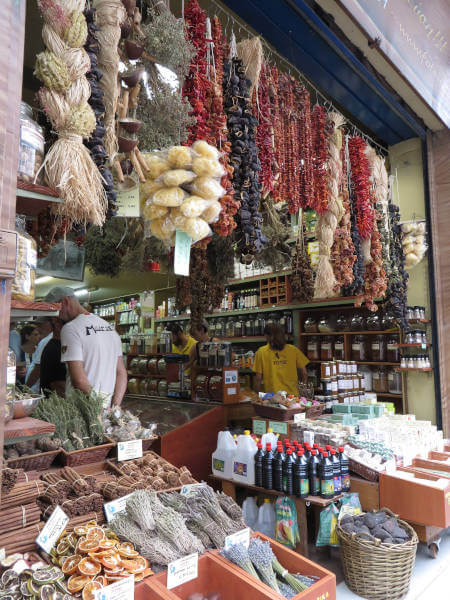
We left the building wanting to investigate the surrounding streets. We knew that the city's most assorted spice stores are located in this area and, being in constant search of dried chilies and ingredients for our Mexican dishes, we went to one of the most famous. Total change of scenery! We entered a rustic-style store with chili and garlic braids hanging from its gate.
Here it smells rich, of cinnamon, pepper, anise, oregano and other flavorings, usual and not so much. Vanilla and aromatic oils, as well as flours and salts. Also, there is hibiscus flower that is not so used here, sacks of various types of rice and canning of various fruits in syrup. We bought our kilo of basmati and two bags of hibiscus flower, for a euro each, and we went out again.
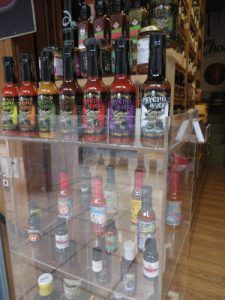
Immediately in front, there is an attractive little store that is different from the others. We went over to see what it was about and with amazement we found several jars of hot sauces and cans of dried chilies, Mexican and from other parts of the world. The owner, a young man very attentive to his business, very kindly explained his products to us and opened the jars of chili peppers for us to smell and touch, thus witnessing their freshness. The sauces that it handles are not only Mexican but from several other countries with spicy cuisine, several being from the United States. To continue our visit, we say goodbye to him for the moment. He told us that he was going on vacation in a few days and we promised to return in September, when it opened again.
The good thing about this market is its location so central that it even made us think that we could easily make our purchases there, finding a great variety of merchandise at much more affordable prices than the butchers in our area. In addition, a visit to this area is a culinary adventure and not only, since it offers walks among merchandise that is not so easy to find elsewhere. We will definitely be back.
Third Chronicle: The Athenian Supply Center
In another part of the city, to the southwest, is the wholesale market, known to most of the population as the vegetable market. Not only does it supply the collection stores of Athens, those of Pireaus, a port city that borders the capital city and practically, those of the entire country, but in recent years, it has expanded to include meat and soon, fish and seafood. In a space that occupies around 26 hectares, it can be stocked with about 350 stores that offer their fruits and vegetables at wholesale prices.
Like good Mexican-Greeks (we have some gifts in common), we enter through the exit and exit through the entrance. As we entered the compound, the first corridor lay wide in front of us. We began to visit their establishments to get to know them and see the products they offer. The stores are elevated with a platform that passes in front of them and that serves for the trailers to join to unload their merchandise. So on one side are the businesses, while on the other, the trucks and pallets full of merchandise, waiting for them to be accommodated inside or to be taken to the business that will sell the products they carry.
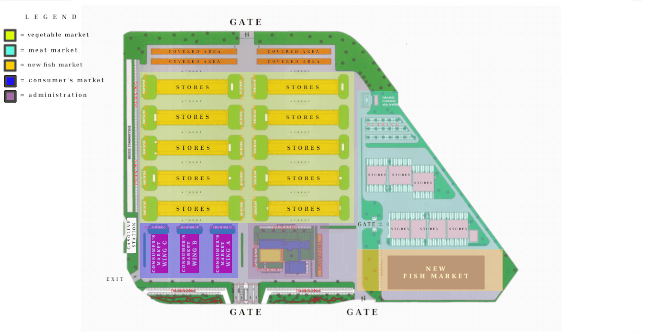
Click to view large
In the aisle that forms in the middle, shoppers are going through and sorting out the fruits and vegetables that will be stocked. We did not go early, when the market is at its most alive, mostly so as not to get in the way and be pushed in our attempt to record everything that happens around. The first memory of Mexico touched our ears in the form of whistles. Not so strong perhaps, considering the low congregation of people, but with the same purpose of not running over the heavy devils. We would jump into holes formed by boxes, taking photos and videos of what happened.

Being in the middle of summer, there was a lot of watermelon and melon, followed by the other summer fruits like peaches, strawberries, tomatoes and a few grapes that were just about to be harvested. There were those of most of the year such as apples, pears, kiwis, bananas, etc. You have to take into account the geographical location and the size of the country to understand its availability. Its entire surface is almost 132,000 km², counting the around 6000 islands that are part of its sovereignty. The highest mountain is Olympos, the home of the ancient gods, with an elevation of almost 3,000 meters above sea level. The land that the small nation owns simply does not allow the production of large varieties of fruits and those that do occur are harvested in the seasons that ripen. Everything that is marketed out of its time, or imported or grown in greenhouses.
But what a surprise we were when asking, we were able to locate tomatillos! Although we were left with the craving for not having that day, we consider that our find was quite important. According to the manager, products from Mexico often arrive.

Most of the fruits we saw were those that are usually offered, but there were also imported ones. We went through exotic, not endemic to Greece, like papayas, nonis, mangoes and pineapples. There were avocados grown on the island of Crete or imported, mostly from Africa. We were speechless to see large quantities already ripe, which is not usually the case in other markets. Too bad it is not advisable to travel about 40 kms. round trip, to buy the day!
At first glance, there were green, red and orange peppers, the “quérato” (κέρατο) that are similar to the güeros and that come in spicy and non-spicy varieties and the “florinis” (φλωρίνης), a red pepper that originally arrived in the Columbus caravels but unfortunately, it does not sting. What you normally see in all markets. Hoping to find some that are biting, we began to review the merchandise more diligently and effectively, within the sea of "deadly" peppers that occur here, we found jalapeños and serranos !.
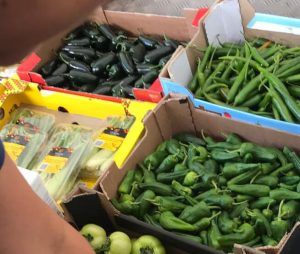
As far as herbs are concerned, there is what is mostly found in all markets, although coriander, more easily here. There is parsley, mint, dill, thyme and others and of course, all the quelites that are used in the country.
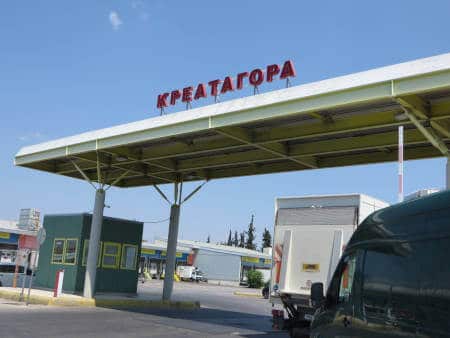
Passing the five sets of complexes that are spread out in rows of two and to one side of the market, are the 25 meat shops and the space where the fish and seafood market will be built. They are called stores where the butcher shops that have joined the project have been established but in reality, from the outside they seem more doors, similar to those of the airports, where the trailers approach, almost fitting in to load and unload their merchandise. We approached to ask since there was no movement and entering through the door that is next to where the trucks are coupled, three men were seated who explained to us that buyers enter to choose their meat and then they are sent or if they prefer , they take it in their own transport.
These are spaces for the preparation and storage of meats and their derivatives. It is worth mentioning that the fruit and vegetable market, the meat market and the fish and seafood market, whose operation has been approved to concentrate the 11 regional fishing markets scattered around the country, all belong to the Central Market and Fisheries Agency (OKAA for its acronym in Greek), the largest food park management company in the Balkans.

In addition, within the same group of markets, there is the “Consumer Market” or the section of shops that offer their merchandise at retail price. The stores that make up this section offer meats, fish, regional products, frozen foods, nuts, vegetables and groceries in general. The products are in well-kept and buyer-friendly spaces, but most of all, they are of excellent quality and offered at very affordable prices.
One of the stores we entered was for products from the island of Crete, with organic products made by various producers who came together to offer their wares to the people of the country's capital. Another that we visited, a recaudería, run by a family with years in the wholesale trade, offers its products to the consumer at wholesale prices, in the spirit of this market. Also, we were struck by a fish shop that sells beer with sea water! and sea water of a liter by a dispensing machine. In general, we are left with a good taste of all the businesses that we find in the “Consumer Market” that, apart from being the retail section, has coffee and food businesses.
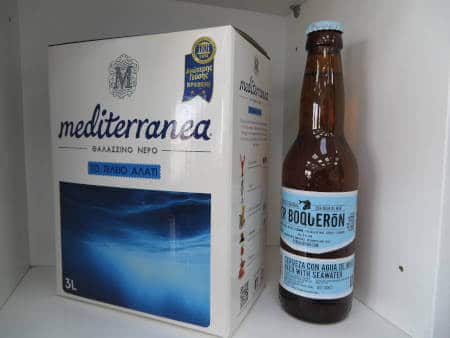
Beer made from sea water 
Organic products from Crete
As I mentioned, we left through the entrance to go to the metro station, about 700 meters away. Although somewhat removed from people like us who live in the northern suburbs of the city, the location of the emerging Central de Abastos de Atenas is perfect being between the subway lines, the suburban train lines and the highway that is practically the spinal cord that connects all of Greece. In addition, it is very close to the port city of Piraeus, the eighth busiest port in Europe in terms of container movement and also serves the southwestern suburbs of Athens. This market has definitely been built exactly where it was supposed to be.
Resume
The truth is that we really enjoyed our adventures in the markets and tianguis of the capital of Greece. It gave us the opportunity to know the products offered here and their points of sale. Comparing them with the respective ones from Mexico is a bit like putting two fighters of different weights in the same arena.
Contrasting Mexico City with all of Greece, the first thing that stands out is its populations. With an estimated 21 million people, Mexico City is clearly separated from that of Greece, which only reaches half. Not to mention the only 5 million inhabitants of Athens.

Courtesy of AlejandroLinaresGarcia
License: [CC BY-SA 4.0]
It is easy to understand that the markets in Mexico that serve so many people have to be much larger. Even so, those of both countries have the same purpose: to provide the population with food products. To supply an area, a city or a country, an infrastructure is needed that may be similar but that always depends on the people and their culture in its operation.
Ours was an investigation in the place of our residence, however, our interest and desire to know extends throughout Europe and even further afield. Personally, wherever I have traveled, I always make time to visit local markets and get to know their products.
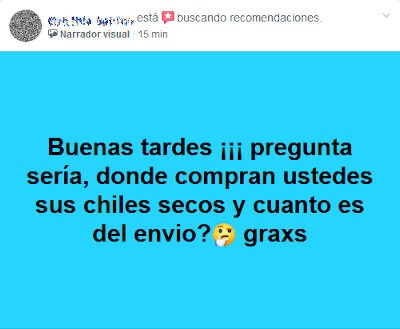
Every day, we witness a large number of expatriate Mexicans and other lovers of our culinary culture, who ask and offer advice on social networks, about where to find products from the Aztec country and what to use instead. There are many people, newcomers to the old continent who do not know where to go to find the necessary ingredients to cook their favorite dishes.
And you, where do you usually buy the products to make your favorite dishes in Mexico? Tell us which ingredients are hard to find where you live and how you get them. Where do you usually buy them from? Is there a market or flea market in your area? Leave your comments and suggestions below and help someone find the materials to prepare their delicious recipes. It will kill you!
